Locating and Imaging through Scattering Medium in a Large Depth
Abstract
1. Introduction
2. Principle
2.1. Basics of Locating and Imaging
2.2. DL Framework Implementation
2.3. Setup and Data Acquisition
3. Results and Analysis
3.1. Quantitative Evaluation in the Whole Working Stroke
3.2. Depth-Resolved Results with Randomly Distributed Objects in a Plane and Different Sizes of the Objects
3.3. Generalization Capability
4. Discussion
- (i)
- DINet is a novel framework that has good performance in locating and imaging through scattering medium in a large depth. This method can obtain accurate depth and imaging results in a large depth ranging from 350 mm to 1150 mm in strong scattering, with a mean error less than 0.05 mm in depth prediction and an average PSNR above 24 dB in image reconstruction.
- (ii)
- DINet has great robustness in depth-resolved capability and good generalization performance in unseen planar position and unseen axial depth. DINet can locate and reconstruct the correct objects with high accuracy, even for the no-fixed position objects in the plane in different depths. For the locating capability of DINet, it should be noted that the depth-resolved capability of DINet is mainly relevant to the depth of the object and has nothing with the size of the object. Meanwhile, DINet has depth generalization capability to regress the depth value and reconstruct the objects with an unseen depth in the training process.
- (iii)
- It should be clarified that DINet has different performance in locating and imaging with different scenarios. The locating accuracy and imaging quality of DINet are limited with the sensitivity of the CMOS with different working distances and the complexity of the dataset. The depth generalization capability also depends on the sampling strategy and the distribution of the training dataset.
5. Conclusions
Author Contributions
Funding
Acknowledgments
Conflicts of Interest
Appendix A
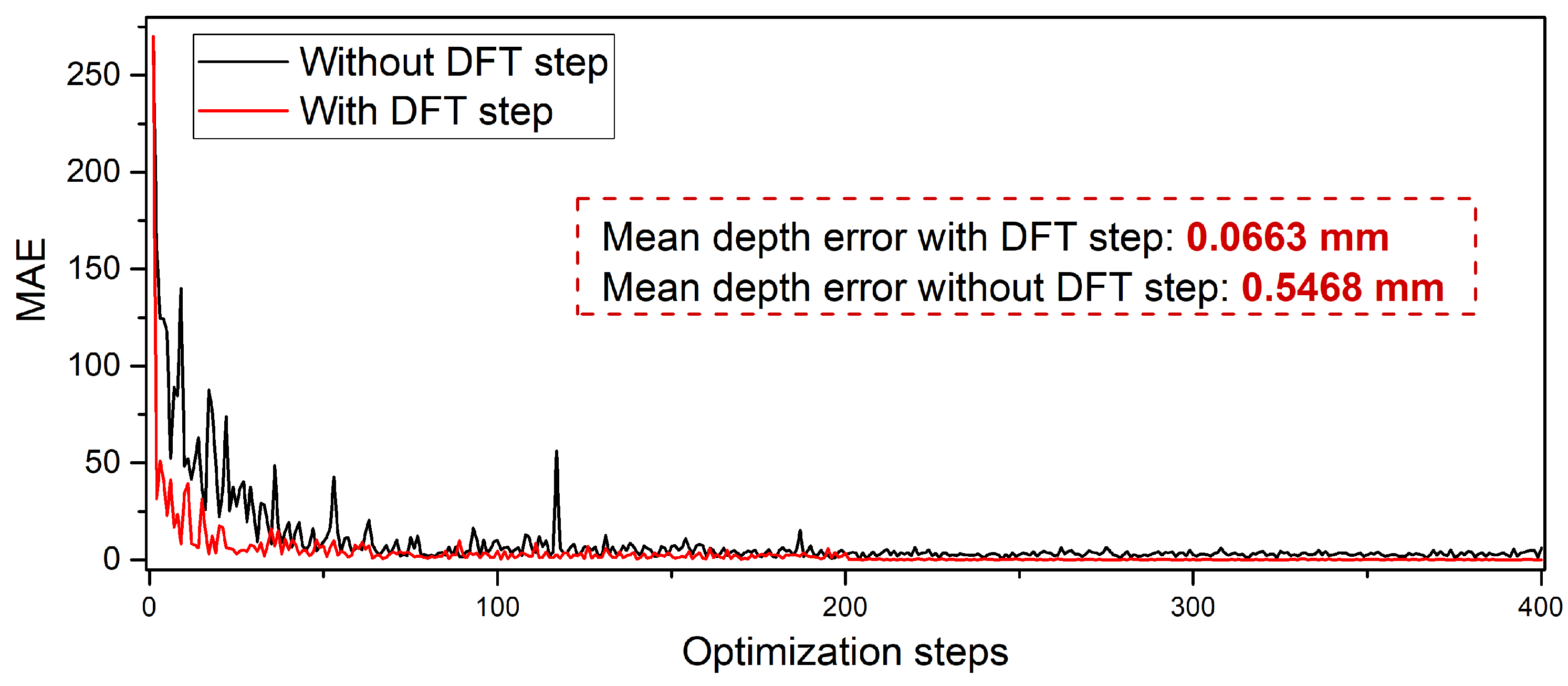
Appendix B
| Type | Output Size | ||
|---|---|---|---|
| Step 0 | DFT Step | ||
| Encoder | Step 1 | Downsample Layer | |
| Step 2 | Downsample Layer | ||
| 5 × Non-bt-1D | |||
| Step 3 | Downsample Layer | ||
| Non-bt-1D (dilated 2) | |||
| Non-bt-1D (dilated 4) | |||
| Non-bt-1D (dilated 6) | |||
| Non-bt-1D (dilated 8) | |||
| Non-bt-1D (dilated 2) | |||
| Non-bt-1D (dilated 4) | |||
| Non-bt-1D (dilated 6) | |||
| Non-bt-1D (dilated 8) | |||
| Decoder | Step 4 | Average pooling Layer | |
| Step 5 | Fully connected Layer | 12,800 | |
| Fully connected Layer | 1000 | ||
| Fully connected Layer | 1 |
| Type | Output Size | ||
|---|---|---|---|
| Encoder | Step 0 | Downsample Layer | |
| Step 1 | Downsample Layer | ||
| 5 × Non-bt-1D | |||
| Step 2 | Downsample Layer | ||
| Non-bt-1D (dilated 2) | |||
| Non-bt-1D (dilated 4) | |||
| Non-bt-1D (dilated 6) | |||
| Non-bt-1D (dilated 8) | |||
| Non-bt-1D (dilated 2) | |||
| Non-bt-1D (dilated 4) | |||
| Non-bt-1D (dilated 6) | |||
| Non-bt-1D (dilated 8) | |||
| Decoder | Step 3 | Upsample Layer | |
| 2 × Non-bt-1D | |||
| Step 4 | Upsample Layer | ||
| 2 × Non-bt-1D | |||
| Step 5 | Upsample Layer |
References
- Ntziachristos, V. Going deeper than microscopy: The optical imaging frontier in biology. Nat. Methods 2010, 7, 603–614. [Google Scholar] [CrossRef] [PubMed]
- Gibson, A.; Hebden, J.; Arridge, S.R. Recent advances in diffuse optical imaging. Phys. Med. Biol. 2005, 50, R1. [Google Scholar] [CrossRef] [PubMed]
- Goodman, J.W. Speckle Phenomena in Optics: Theory and Applications; Roberts and Company Publishers: Greenwood Village, CO, USA, 2007. [Google Scholar]
- Tajahuerce, E.; Durán, V.; Clemente, P.; Irles, E.; Soldevila, F.; Andrés, P.; Lancis, J. Image transmission through dynamic scattering media by single-pixel photodetection. Opt. Express 2014, 22, 16945–16955. [Google Scholar] [CrossRef] [PubMed]
- Xu, Y.K.; Liu, W.T.; Zhang, E.F.; Li, Q.; Dai, H.Y.; Chen, P.X. Is ghost imaging intrinsically more powerful against scattering? Opt. Express 2015, 23, 32993–33000. [Google Scholar] [CrossRef] [PubMed]
- Jeong, S.; Lee, Y.R.; Choi, W.; Kang, S.; Hong, J.H.; Park, J.S.; Lim, Y.S.; Park, H.G.; Choi, W. Focusing of light energy inside a scattering medium by controlling the time-gated multiple light scattering. Nat. Photonics 2018, 12, 277–283. [Google Scholar] [CrossRef]
- Kanaev, A.; Watnik, A.; Gardner, D.; Metzler, C.; Judd, K.; Lebow, P.; Novak, K.; Lindle, J. Imaging through extreme scattering in extended dynamic media. Opt. Lett. 2018, 43, 3088–3091. [Google Scholar] [CrossRef]
- Vellekoop, I.M.; Mosk, A. Focusing coherent light through opaque strongly scattering media. Opt. Lett. 2007, 32, 2309–2311. [Google Scholar] [CrossRef]
- Popoff, S.; Lerosey, G.; Carminati, R.; Fink, M.; Boccara, A.; Gigan, S. Measuring the transmission matrix in optics: An approach to the study and control of light propagation in disordered media. Phys. Rev. Lett. 2010, 104, 100601. [Google Scholar] [CrossRef]
- Drémeau, A.; Liutkus, A.; Martina, D.; Katz, O.; Schülke, C.; Krzakala, F.; Gigan, S.; Daudet, L. Reference-less measurement of the transmission matrix of a highly scattering material using a DMD and phase retrieval techniques. Opt. Express 2015, 23, 11898–11911. [Google Scholar] [CrossRef]
- Bertolotti, J.; Van Putten, E.G.; Blum, C.; Lagendijk, A.; Vos, W.L.; Mosk, A.P. Non-invasive imaging through opaque scattering layers. Nature 2012, 491, 232–234. [Google Scholar] [CrossRef]
- Katz, O.; Heidmann, P.; Fink, M.; Gigan, S. Non-invasive single-shot imaging through scattering layers and around corners via speckle correlations. Nat. Photonics 2014, 8, 784–790. [Google Scholar] [CrossRef]
- Porat, A.; Andresen, E.R.; Rigneault, H.; Oron, D.; Gigan, S.; Katz, O. Widefield lensless imaging through a fiber bundle via speckle correlations. Opt. Express 2016, 24, 16835–16855. [Google Scholar] [CrossRef] [PubMed]
- Lu, D.; Liao, M.; He, W.; Pedrini, G.; Osten, W.; Peng, X. Tracking moving object beyond the optical memory effect. Opt. Lasers Eng. 2020, 124, 105815. [Google Scholar] [CrossRef]
- Zhu, L.; Wu, Y.; Liu, J.; Wu, T.; Liu, L.; Shao, X. Color imaging through scattering media based on phase retrieval with triple correlation. Opt. Lasers Eng. 2020, 124, 105796. [Google Scholar] [CrossRef]
- Lyu, M.; Wang, H.; Li, G.; Zheng, S.; Situ, G. Learning-based lensless imaging through optically thick scattering media. Adv. Photonics 2019, 1, 036002. [Google Scholar] [CrossRef]
- LeCun, Y.; Bengio, Y.; Hinton, G. Deep learning. Nature 2015, 521, 436–444. [Google Scholar] [CrossRef]
- Li, S.; Deng, M.; Lee, J.; Sinha, A.; Barbastathis, G. Imaging through glass diffusers using densely connected convolutional networks. Optica 2018, 5, 803–813. [Google Scholar] [CrossRef]
- Li, Y.; Xue, Y.; Tian, L. Deep speckle correlation: A deep learning approach toward scalable imaging through scattering media. Optica 2018, 5, 1181–1190. [Google Scholar] [CrossRef]
- Borhani, N.; Kakkava, E.; Moser, C.; Psaltis, D. Learning to see through multimode fibers. Optica 2018, 5, 960–966. [Google Scholar] [CrossRef]
- Sun, Y.; Shi, J.; Sun, L.; Fan, J.; Zeng, G. Image reconstruction through dynamic scattering media based on deep learning. Opt. Express 2019, 27, 16032–16046. [Google Scholar] [CrossRef]
- Guo, E.; Zhu, S.; Sun, Y.; Bai, L.; Zuo, C.; Han, J. Learning-based method to reconstruct complex targets through scattering medium beyond the memory effect. Opt. Express 2020, 28, 2433–2446. [Google Scholar] [CrossRef] [PubMed]
- Takasaki, K.T.; Fleischer, J.W. Phase-space measurement for depth-resolved memory-effect imaging. Opt. Express 2014, 22, 31426–31433. [Google Scholar] [CrossRef] [PubMed]
- Xie, X.; Zhuang, H.; He, H.; Xu, X.; Liang, H.; Liu, Y.; Zhou, J. Extended depth-resolved imaging through a thin scattering medium with PSF manipulation. Sci. Rep. 2018, 8, 4585. [Google Scholar] [CrossRef] [PubMed]
- Xie, J.; Xie, X.; Gao, Y.; Xu, X.; Liu, Y.; Yu, X. Depth detection capability and ultra-large depth of field in imaging through a thin scattering layer. J. Opt. 2019, 21, 085606. [Google Scholar] [CrossRef]
- Salhov, O.; Weinberg, G.; Katz, O. Depth-resolved speckle-correlations imaging through scattering layers via coherence gating. Opt. Lett. 2018, 43, 5528–5531. [Google Scholar] [CrossRef]
- Waller, L.; Situ, G.; Fleischer, J.W. Phase-space measurement and coherence synthesis of optical beams. Nat. Photonics 2012, 6, 474–479. [Google Scholar] [CrossRef]
- Bastiaans, M.J. Applications of the Wigner distribution function to partially coherent light beams. In Selected Papers from International Conference on Optics and Optoelectronics’ 98; International Society for Optics and Photonics: Bellingham, WA, USA, 1999; Volume 3729, pp. 114–128. [Google Scholar]
- Alonso, M.A. Wigner functions in optics: Describing beams as ray bundles and pulses as particle ensembles. Adv. Opt. Photonics 2011, 3, 272–365. [Google Scholar] [CrossRef]
- Romera, E.; Alvarez, J.M.; Bergasa, L.M.; Arroyo, R. Erfnet: Efficient residual factorized convnet for real-time semantic segmentation. IEEE Trans. Intell. Transp. Syst. 2017, 19, 263–272. [Google Scholar] [CrossRef]
- Ronneberger, O.; Fischer, P.; Brox, T. U-net: Convolutional networks for biomedical image segmentation. arXiv 2015, arXiv:1505.04597. [Google Scholar]
- Guo, C.; Liu, J.; Wu, T.; Zhu, L.; Shao, X. Tracking moving targets behind a scattering medium via speckle correlation. Appl. Opt. 2018, 57, 905–913. [Google Scholar] [CrossRef]
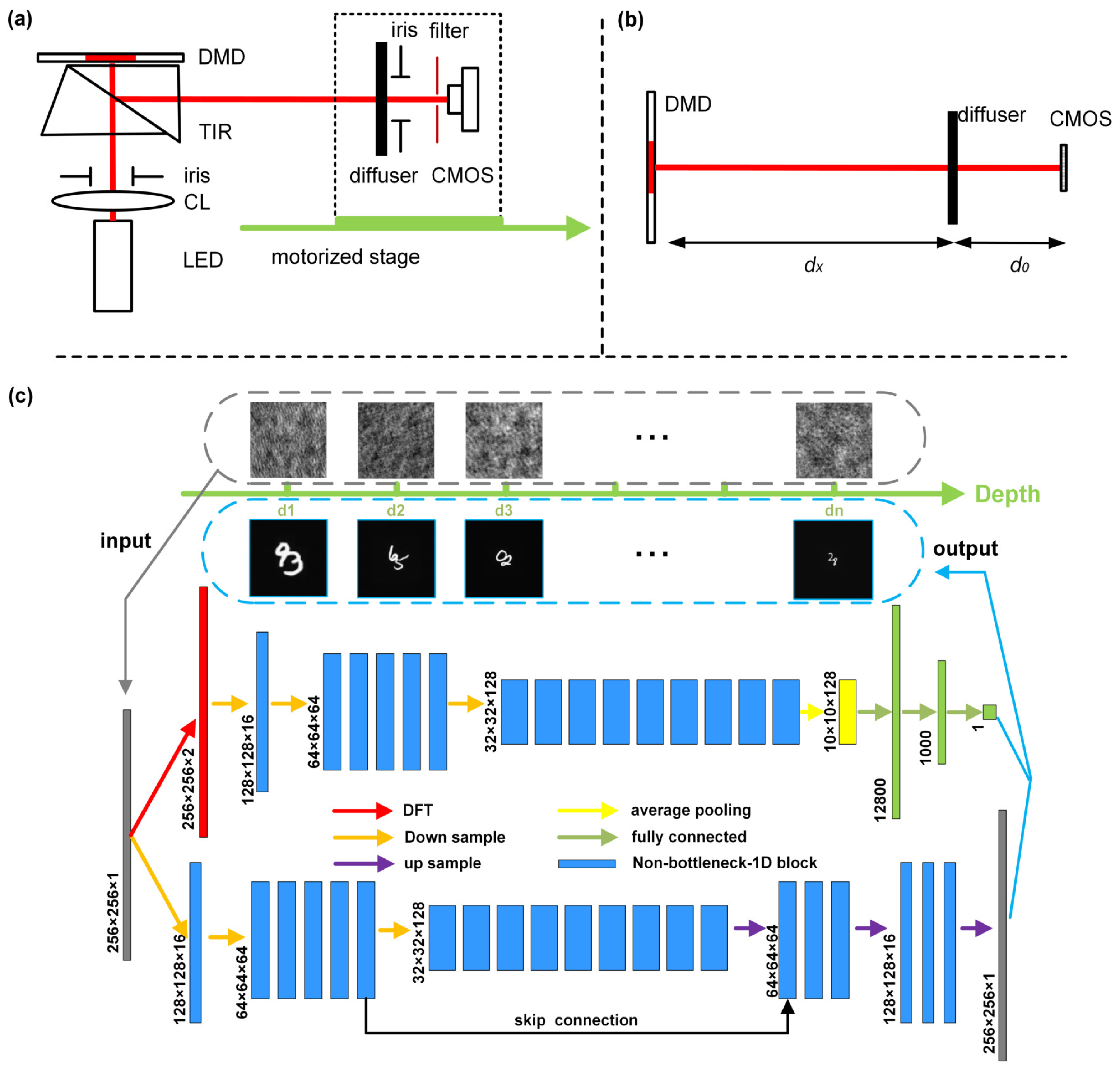
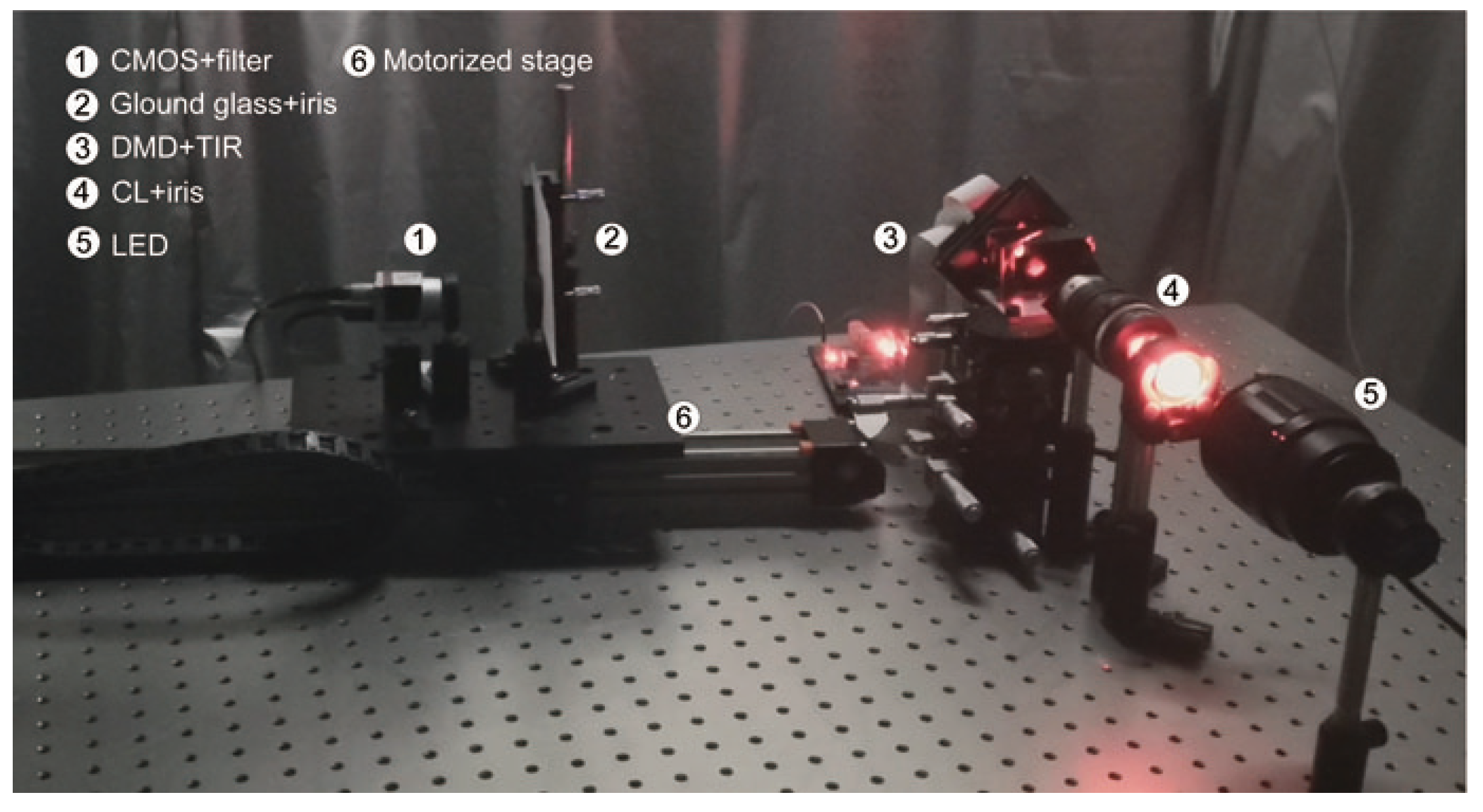
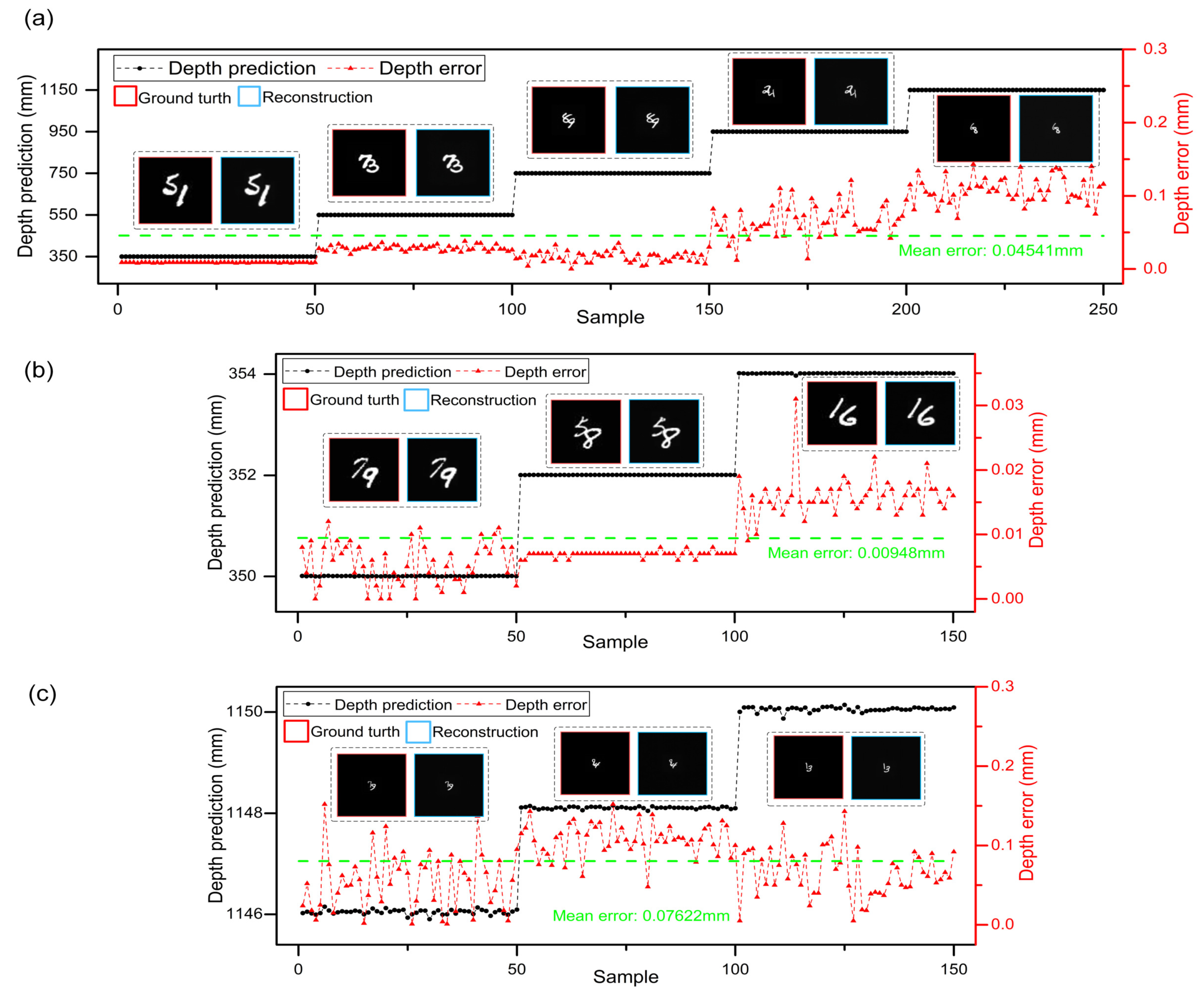
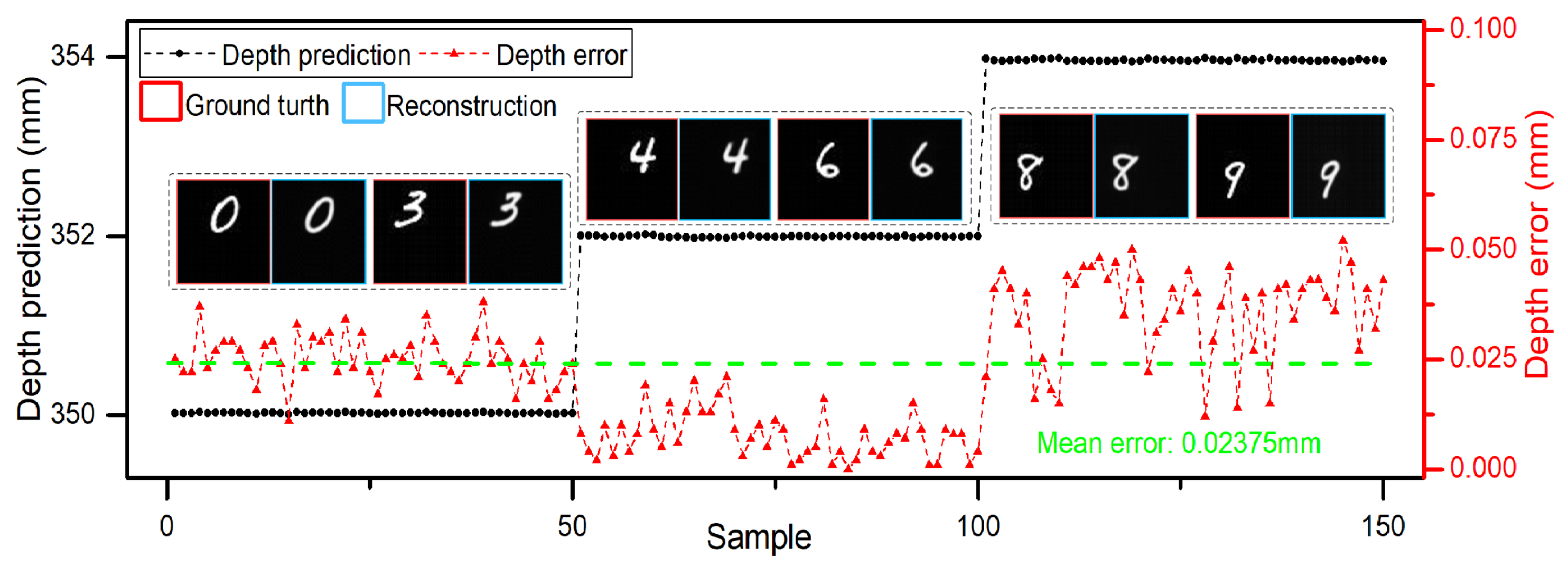
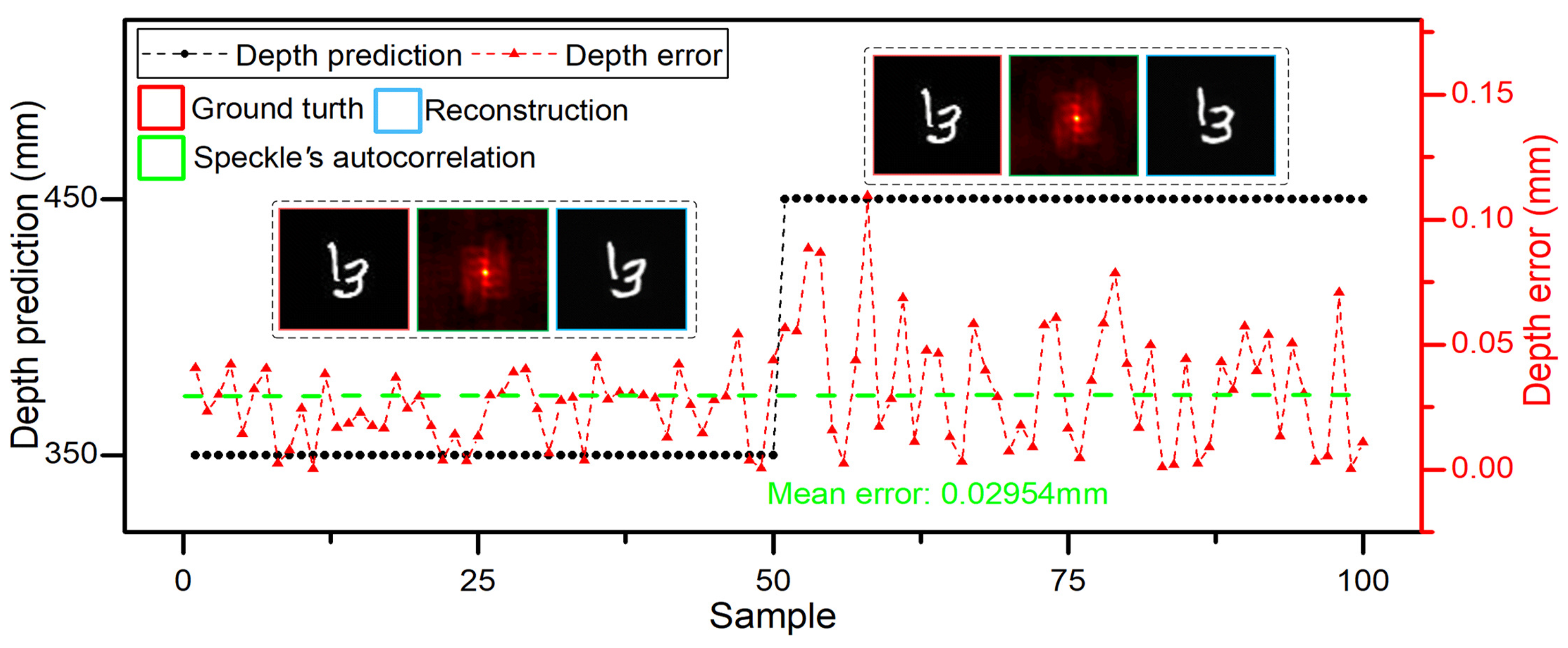

| Depth Value (mm) | 350 | 550 | 750 | 950 | 1150 | |
|---|---|---|---|---|---|---|
| Imaging-path of DINet [22] | MAE | 0.0145 | 0.0155 | 0.0159 | 0.0168 | 0.0188 |
| PSNR (dB) | 25.51 | 25.02 | 24.82 | 24.46 | 23.73 | |
| Unet [31] | MAE | 0.0214 | 0.0203 | 0.0195 | 0.0196 | 0.0201 |
| PSNR (dB) | 21.88 | 22.58 | 22.92 | 22.88 | 22.83 | |
| Dense-Unet [19] | MAE | 0.0240 | 0.0243 | 0.0263 | 0.0274 | 0.0294 |
| PSNR (dB) | 21.53 | 21.59 | 21.10 | 20.98 | 20.40 | |
| Training Depth (mm) | Generalization Depth (mm) | Mean Error (mm) |
|---|---|---|
| 352, 354, 356, 358 | 350 | 0.66128 |
| 350, 352, 356, 358 | 354 | 0.21434 |
| 350, 352, 354, 356 | 358 | 0.52759 |
| 350, 550, 950, 1150 | 750 | 48.3811 |
Publisher’s Note: MDPI stays neutral with regard to jurisdictional claims in published maps and institutional affiliations. |
© 2020 by the authors. Licensee MDPI, Basel, Switzerland. This article is an open access article distributed under the terms and conditions of the Creative Commons Attribution (CC BY) license (http://creativecommons.org/licenses/by/4.0/).
Share and Cite
Zhu, S.; Guo, E.; Cui, Q.; Bai, L.; Han, J.; Zheng, D. Locating and Imaging through Scattering Medium in a Large Depth. Sensors 2021, 21, 90. https://doi.org/10.3390/s21010090
Zhu S, Guo E, Cui Q, Bai L, Han J, Zheng D. Locating and Imaging through Scattering Medium in a Large Depth. Sensors. 2021; 21(1):90. https://doi.org/10.3390/s21010090
Chicago/Turabian StyleZhu, Shuo, Enlai Guo, Qianying Cui, Lianfa Bai, Jing Han, and Dongliang Zheng. 2021. "Locating and Imaging through Scattering Medium in a Large Depth" Sensors 21, no. 1: 90. https://doi.org/10.3390/s21010090
APA StyleZhu, S., Guo, E., Cui, Q., Bai, L., Han, J., & Zheng, D. (2021). Locating and Imaging through Scattering Medium in a Large Depth. Sensors, 21(1), 90. https://doi.org/10.3390/s21010090





